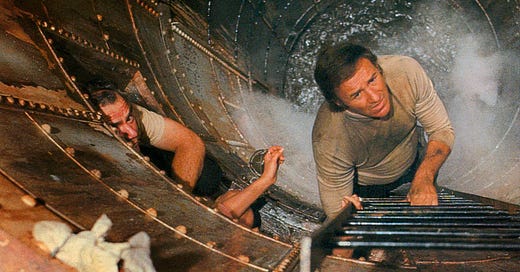The Poseidon Adventure (1972)
Movie rating: 8/10
Spoilers ahead.
The 1970s saw the first great disaster movie boom, which began with Airport in 1970 and continued with the likes of The Poseidon Adventure (1972), Earthquake (1974), and The Towering Inferno (1974).
I’m always fascinated in why certain ideas and trends become popular at certain times. I don’t believe it’s a coincidence that Hollywood embraced disaster films at the same time the United States was being torn apart by what was increasingly acknowledged as a national disaster, the war in Vietnam. The period that gave rise to the antiwar movement saw movements against racism, for women’s rights and gay rights. The U.S.A. was a highly divided country and this inevitably found expression in American cinema, albeit in a way that sought to overcome those divisions.
Disaster films of this era tend to follow a standard formula. An all-star cast represents people from diverse backgrounds who are forced in the wake of calamity to overcome their differences and work together. It’s the kind of wish fulfillment that, combined with star wattage and large-scale spectacle, makes it easy to see why these films were such crowd pleasers.
The Poseidon Adventure, directed by Ronald Neame and produced by disaster film maestro Irwin Allen, is a perfect example. Bringing together a cast that includes five Oscar winners, the film tell the story of the S.S. Poseidon, an aging ocean liner that capsizes during a tsunami, and the struggle for survival of passengers trying to escape. Our core characters include Rev. Frank Scott (Gene Hackman), an unorthodox minister; police detective lieutenant Mike Rogo (Ernest Borgnine) and his wife Linda (Stella Stevens), a former prostitute; elderly Jewish couple Manny and Belle Rosen (Jack Albertson and Shelley Winters), travelling to visit their infant grandson for the first time; two siblings (Pamela Sue Martin and Eric Shea) going to see their parents on vacation; waiter Acres (Roddy McDowall), haberdasher James Martin (Red Buttons), and ship’s singer Nonnie Parry (Carol Lynley). When the ship flips upside down, Rev. Scott attempts to lead them upward to safety through the outer hull.
Thematically, this movie spoke to me. The idea that disaster can strike at any time is hammered home when the ship flips shortly after the stroke of midnight on New Year’s Eve. Passengers who have gathered in celebration, singing “Auld Lang Syne” at a traditional moment of hope for the future, all of a sudden find themselves trying desperately to stay alive. Facing death has a way of reminding us how precious life is. But pushing onward when we lose the ones we love can be difficult. In one scene, Nonnie doesn’t feel that she can go on after her brother has died. Martin responds: “Nonnie, you will go on. We do, you know. We have to. At first we don't think it's possible, but in time, believe me, in time you'll find other things, other people. Someone else to care for. You'll see.”
The character arc of Rev. Scott explores how setbacks, tragedies, and loss can test our faith. Scott is a believer in the idea, as he preaches in a sermon early in the film, that “God helps those who help themselves.” Yet as disasters and death pile up, Scott begins to question his beliefs. Finding their escape route blocked by steam near the end, he yells out to God:
What more do you want of us? We've come all this way, no thanks to you. We did it on our own, no help from you. We did ask you to fight for us but damn it, don't fight against us! Leave us alone! How many more sacrifices? How much more blood? How many more lives? Belle wasn't enough. Acres wasn't. Now this girl!
Finally Scott sacrifices himself to save the others. “You want another life?” Scott asks. “Then take me!”
Viewers can interpret this in an atheist or a Christian way. You can take the story of the S.S. Poseidon and its passengers as revealing the absence of God, the senselessness of death in an uncaring universe, and the struggle for existence of all living beings who don’t know when and where death will come. Or you can take it as illustrating Christian values, such as sacrificing oneself to save others. Per John 15:13: “Greater love hath no man than this, that a man lay down his life for his friends.” (Of course, similar ideas are prevalent among those of other faiths and no faith.)
Though one can read these deeper themes into the movie, its main appeal is as an exciting disaster film. We watch these characters try to navigate their way out of the ship, help each other, and stay alive. It’s a corny old formula, but it works. The characters are familiar types made interesting to watch by talented actors. There are some suspenseful scenes, including some long shots with the actors swimming underwater. The sets are incredible, tilting for the sequence in which the ship overturns, and then upside down for the rest of the film.
At least some of the protagonists always survive movies like this, but I could have done without the onscreen text that starts the film which confirms that to the viewer. Still, the filmmakers keep ramping up the tension until the end. When the last survivors finally emerge from the ship, the audience feels as relieved as the characters. The movie accomplishes what it sets out to do, making this an enjoyable watch.




